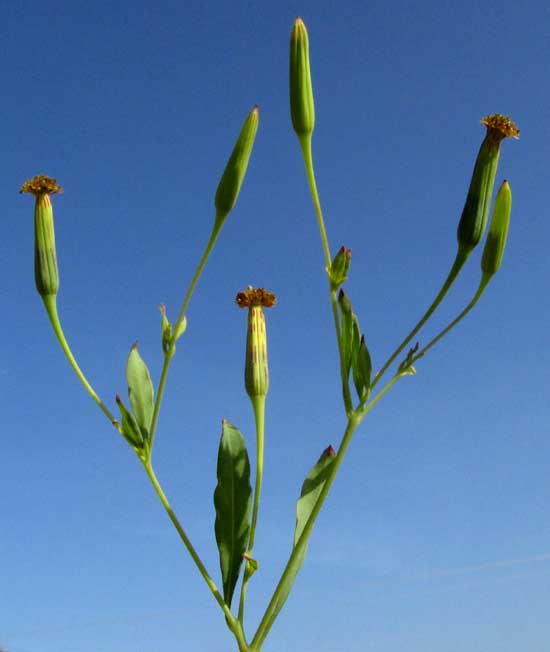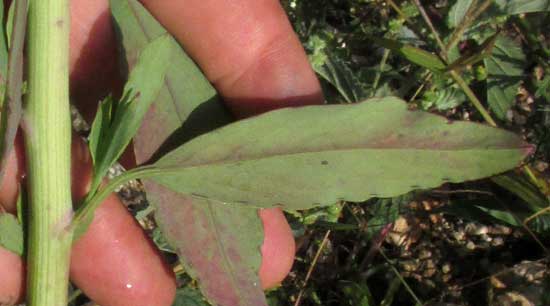Excerpts from Jim Conrad's
Naturalist Newsletter
from the August 7, 2016 Newsletter issued from Hacienda Chichen Resort beside Chichén Itzá Ruins; limestone bedrock; elevation ~39m (~128ft), N20.675°, W88.569°; central Yucatán state, MÉXICO
PORELEAF
This week when I biked to the rock quarry just south of Xcalacoop something turned up looking different. Below, you can see the shoulder-high herb topped with a large flowering head :

Even from a distance it had the Composite or Daisy Family look about it. It might have been a prickly lettuce, though the leaves didn't bear prickles. Members of the Composite Family bear little "heads" of flowers, called capitula, in which two kinds of flowers, or "florets," may occur: disc flowers or ray flowers. The capitula of most composite species bear both disc and ray florets, but the capitula of some groups contain only discs or only rays. Prickly lettuce flowers, genus Lactuca, produce only ray flowers. Our rock quarry composite's capitula bore only disc flowers, like bonesets or eupatoriums up north, as shown below:

One capitulum in the head was mature enough for its florets to have produced cypsela-type fruits topped with white parachutes -- again like the prickly lettuces -- as seen below:

The leaves and stem displayed a slight silvery sheen or bloom, as seen below:

Sunlight glare was bad that day and my vision is bad, too, so it wasn't until the above image was on the computer screen that I saw the dark little dashes along the leaves' margins. The dashes and accompanying indentations of the leaf margins, making them slightly wavy, or crenate, reminded me that we'd seen something like this before. In 2008, in Sabacché in southern Yucatán state, we captured the image shown below:

That interestingly fragrant leaf displayed marginal, dash-like glands filled with sweet-musky-smelling compounds, plus there were glands inside the leaf not apparent in this week's leaf picture. Also, that leaf, which was identified as coming from a Porophyllum punctatum, was proportionally broader than the rock-quarry leaf. So, had I found the same species again?
Two Porophyllum species, which in English often are referred to as Poreleafs, are listed for the Yucatan. Leaves of the second species are even broader than this week's quarry one, and the glands display a different appearance. So, this is indeed POROPHYLLUM PUNCTATUM, occurring in most of humid lowland Mexico south through Central America at least to Panama. It's not particularly uniquely adapted to the relatively sterile, hot, sun-baked soil of our rock quarry; it's just a plant with a weed's toughness and adaptability able to survive there.
Our rock quarry individual has leaves that are more slender and possibly thicker -- thus with the glands less in evidence -- than most plants of this species I've run across. I'm guessing that that's because of its extremely hot, sunny environment, and maybe its mature state of development.
As you might guess of any really smelly herb, Porophyllum punctatum traditionally is regarded as medicinal. The online Biblioteca Digital de la Medicina Tradicional Mexicana mentions that it has a long history of use against gonorrhea, as well as for other problems including nasal hemorrhages, chronic ulcers, mange, kidney problems, and for children who sweat during the night when it isn't hot.